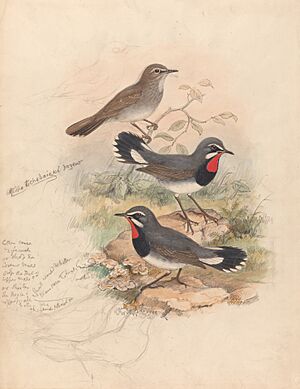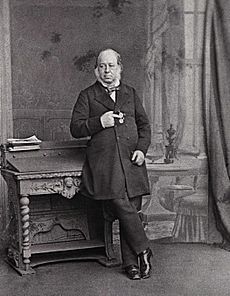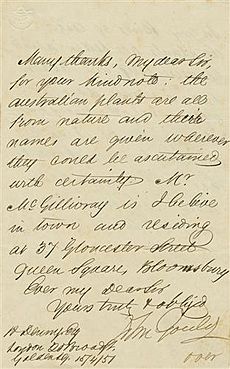John Gould facts for kids
Quick facts for kids
John Gould
|
|
|---|---|
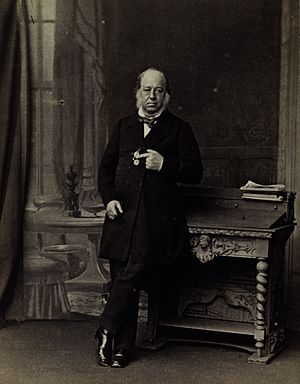 |
|
| Born | 14 September 1804 Lyme Regis, England
|
| Died | 3 February 1881 (aged 76) London, England
|
| Resting place | Kensal Green cemetery |
| Known for | Illustrated monographs on birds, identification of Darwin's finches |
| Spouse(s) | Elizabeth Gould (née Coxen) |
| Children | Charles Gould |
| Scientific career | |
| Fields | Ornithology |
| Institutions | Zoological Society of London |
| Influences | Charles Darwin |
| Author abbrev. (zoology) | Gould |
John Gould (born September 14, 1804 – died February 3, 1881) was an English expert on birds, known as an ornithologist. He created many books about birds, filled with amazing pictures. His wife, Elizabeth Gould, and other artists like Edward Lear drew these pictures.
John Gould is often called the "father of bird study" in Australia. A group called the Gould League in Australia is even named after him. He helped Charles Darwin understand the birds now called "Darwin's finches." This work was important for Darwin's idea of evolution by natural selection.
Contents
Early Life and Career
John Gould was born in Lyme Regis, England. His father was a gardener. John also started working as a gardener when he was young. He worked at the Royal Gardens of Windsor.
He became very good at taxidermy, which is the art of preparing, stuffing, and mounting animal skins to make them look alive. In 1824, he started his own taxidermy business in London. His skills helped him become the first curator and preserver at the museum of the Zoological Society of London in 1827.
Amazing Bird Books
Working at the Zoological Society meant John Gould saw many new bird collections. In 1830, he saw birds from the Himalayas that had never been described before. He published a book about them called A Century of Birds from the Himalaya Mountains. His wife, Elizabeth, drew and printed the pictures for this book.
Over the next seven years, he published four more major works. One of these was Birds of Europe, which had five large volumes. Elizabeth Gould also drew and printed the pictures for this book. Some illustrations were even made by Edward Lear, a famous artist.
These books were very large and had beautiful colored pictures. In total, John Gould published 41 such books with about 3,000 plates. He sold them in parts, and even though they were expensive to make, he became quite wealthy from them.
Working with Charles Darwin
In 1837, Charles Darwin brought his bird specimens from his trip on the HMS Beagle to the Zoological Society of London. John Gould was asked to identify them. He quickly realized that many of the birds Darwin thought were different types were actually a new group of finches. There were 12 different species!
This discovery was very important for Darwin. Gould also told Darwin that the mockingbirds he collected were separate species, not just varieties. Darwin had not labeled his finches by island, but other crew members had. With Gould's help, Darwin realized that different species of finches lived on different islands. This was a key step in Darwin's idea of evolution by natural selection.
Gould's work on these birds was published in a book called Zoology of the Voyage of H.M.S. Beagle. Elizabeth Gould drew all the pictures for this part of the book.
Exploring Australia's Birds

In 1838, John and Elizabeth Gould traveled to Australia. They wanted to study the birds there and create the first big book about them. They spent time collecting birds in Tasmania and on the mainland. John explored places like the Liverpool Range and Kangaroo Island.
Their trip resulted in The Birds of Australia (1840–48). This huge work had seven volumes and 600 plates. It described 328 new bird species that Gould named. He also published books about Australian mammals, like The Mammals of Australia.
Sadly, Elizabeth died in 1841 after giving birth to their eighth child. After her death, other artists like Henry Constantine Richter and Joseph Wolf helped Gould with the illustrations for his books.
Even after returning to England, John Gould kept in touch with scientists in Australia. He wanted any new bird species found to be sent to him to be described and drawn.
Fascinated by Hummingbirds
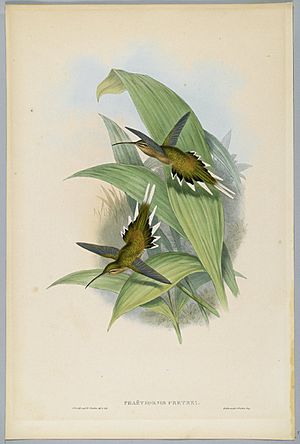
John Gould was very interested in hummingbirds throughout his life. He collected 320 different species! He even showed his collection at the Great Exhibition in 1851.
Even with such a large collection, Gould had never seen a live hummingbird. In 1857, he traveled to the United States. In Philadelphia, he finally saw his first live hummingbird, a ruby-throated hummingbird. He later saw many more in Washington D.C. He tried to bring live hummingbirds back to England, but they only lived for about two months.
Birds of Great Britain
Birds of Great Britain is one of John Gould's most famous works. Experts say he was the most important bird illustrator after John James Audubon. Gould didn't draw every picture himself, but he closely watched over their creation.
This book was special because it included illustrations of bird nests and young birds on a large scale. Gould published 750 copies of the book himself. Each set had 367 colored pictures. These books are still very popular today.
To prepare for the book, Gould traveled to Scandinavia in 1856. He made quick sketches of birds in nature, often from newly collected specimens. Then, his artists would turn these sketches into finished drawings. These drawings were then made into colored lithographs.
The pictures in the book were colored by hand. Gould mentioned that nearly 280,000 individual illustrations in the work were hand-colored. This shows the huge amount of effort that went into making these beautiful books.
Tributes to John Gould
Many animals have been named after John Gould. These include:
- Gould's petrel (a type of seabird)
- Gould's shortwing (a small bird)
- Gould's frogmouth (a bird with a wide mouth)
- Gould's jewelfront and Gould's inca (types of hummingbirds)
- Gould's toucanet (a small toucan)
- Dot-eared coquette and Olive-backed euphonia (other small birds)
Two types of reptiles are also named in his honor:
- Gould's monitor (a lizard, also called a Sand goanna)
- Gould's hooded snake
The Tasmanian giant freshwater crayfish was named after his son, Charles. His wife, Elizabeth, also had birds named after her: Gould's sunbird and the colorful Gouldian finch.
The Gould League in Australia, started in 1909, was named after him. This group helped many Australians learn about birds and nature. John Gould was also honored on postage stamps in Australia in 1976 and 2009.
Family Life
John Gould married Elizabeth Coxen in 1829. They had eight children together. Their youngest son, Charles Gould, became a geological surveyor.
Elizabeth Gould died in 1841 after giving birth to their eighth child, Sarah.
See also
 In Spanish: John Gould para niños
In Spanish: John Gould para niños
- All pages with titles containing "Gouldi" for species named for Gould
- All pages with titles containing "Gouldii" for species named for Gould


